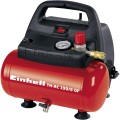Input performance
The amount of air that the compressor is able to process per unit of time; usually stated in liters per minute. Performance, along with pressure (see below), is one of the most important parameters: it is it that primarily determines how compatible the compressor will be with one or another pneumatic tool.
It is worth choosing a model according to this indicator in such a way that it can be guaranteed to “pull out” all the tools that can be connected at the same time. Air consumption is usually directly indicated in the characteristics of each tool, and it is quite simple to calculate the total requirement. However, due to the design features, the compressor must have a certain performance margin; the specific value of this stock depends on a number of nuances.
The main point is that some companies indicate for their units the performance at the outlet (how much air is supplied to the tool), while others indicate at the inlet (how much air the compressor sucks in). Since no compressor is perfect, part of the air is inevitably lost during the compression process, so the amount of air at the outlet will always be less than at the inlet. Accordingly, if the output performance is indicated in the characteristics, a margin of 10-20% is recommended, and if the input is 35-40%.
There are also more complex techniques that allow you to more accurately derive the required performance depending on the characteristics of specific tools; they can be found in...special sources.
Rotation speed
The speed of rotation of the compressor motor shaft in normal operation. This parameter, usually, does not affect the efficiency of the unit — the main indicators are still the performance and nominal pressure (see above). At the same time, it allows you to evaluate the design features of the compressor and its durability. The fact is that a higher rotation speed allows the use of fairly simple and inexpensive working mechanisms, but it increases the wear of moving parts and reduces the motor resource. Therefore, a model with a lower number of revolutions is likely to cost more than the "high-speed" version, but it will also last longer (ceteris paribus characteristics — performance, pressure, drive type, design; see all above).
Receiver
Air tanks, or receivers (for details, see "Receiver volume") for modern compressors are usually made in a shape close to cylindrical, and can have both horizontal and vertical arrangement. Each option has its own characteristics:
— Horizontal. Such receivers require quite a lot of space on the floor (or other surface), but this moment also has a “reverse side” — the area of the upper part of the tank is also quite large, and belt-driven mechanisms can be placed on it without problems (see "Drive") . In addition, the horizontal arrangement allows the use of tanks of almost any volume, from small to very capacious, and the compressors themselves are very stable — it is almost impossible to accidentally overturn such a device. Therefore, this option is by far the most common and is found in the vast majority of models.
— Vertical. The main advantage of such receivers over horizontal ones is the relatively small amount of space required for installation. On the other hand, the vertical layout imposes serious restrictions on the maximum volume of the tank, and a small amount of space on top is usually only suitable for direct drive systems (see above). And the stability of such structures is somewhat worse. Therefore, this option has not received wide popularity, and it is worth specifically looking for a vertical compressor only if the situation does not allow the use of a horizontal model.
— Is absent. Models supplied without any receiver at a...ll.
The main advantages of tankless units are compactness, light weight and relatively low cost. However the air flow from them is relatively uneven, but in many cases this is not a drawback; in addition, various solutions can be used in the design, to some extent compensating for this drawback, and some compressors without a receiver are even positioned as devices for the same airbrushing.
Noise level
The maximum noise level produced by the compressor during operation. When evaluating it, it must be taken into account that the decibel used to evaluate noise is not an absolute value. In fact, this means that noises, for example, 20 dB and 40 dB differ in level not by a factor of 2, but by 100 — it is this multiplicity that corresponds to a difference of 20 dB; a twofold increase corresponds to a 3 dB increase. Therefore, to assess noise levels, it is worth referring primarily to comparative tables. For values found in modern compressors, this table would look something like this:
70 dB — loud conversations at a distance of about 1 m;
75 dB — scream;
80 dB — motorcycle engine with silencer;
85 dB — loud scream;
90 dB — freight train car at a distance of 5-7 m;
95 dB — noise inside the subway car.
Anyway, the lower the level of noise produced by the unit, the more comfortable its use, the less it will “hit on the ears” and increase the volume of the entire set of working instruments.
Noise level (LPA)
The sound pressure level in decibels at a certain distance between the noise source and the ear of the compressor equipment operator. Since people do not work in the immediate vicinity of the compressor, the parameter will be useful for estimating the noise level at a distance. It is most often measured at a distance of 7 m from a working installation, less often at a distance of 1 m.

